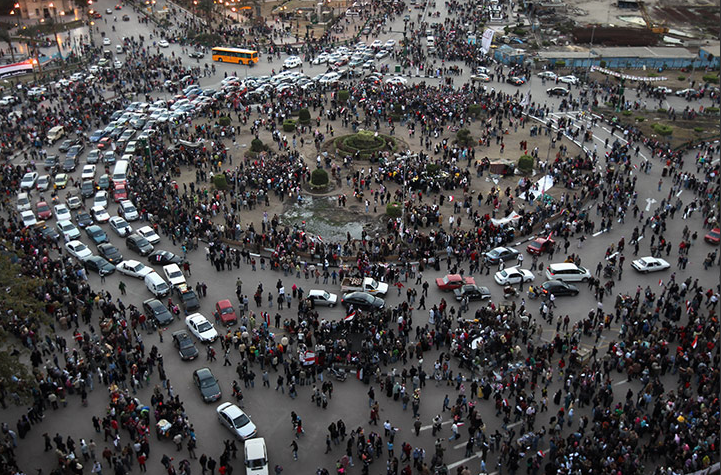It remains to be seen if what we have witnessed in Egypt the past few weeks is a democratic revolution or not. The people have spoken, and it seems that they were heard, but for now the military is in charge. This is not necessarily a bad thing, at least in the short term, and there are reasons to be cautiously optimistic. A functioning democracy requires some modicum of order without, at the same time, stifling individual liberties and the freedom to move about as one chooses. And so far the Egyptian military seems to be mindful of the need to achieve some balance between liberty and order with an eye to the greater concerns of Egypt as a nation state. To accomplish this, of course, one needs to have an eye for both the immediate situation as well as the long view.
The photograph above is distinct in this regard. Most of the photographs turning up at various slide shows are shot from the ground and depict members of the military microscopically, up close and personal, as they work with a wide array of civilian volunteers to convert Tahrir Square back into an open and vital public sphere—removing barricades, helping with the general cleanup, and so on. There are a few instances where the military is shown policing protestors who simply don’t want to give up their makeshift campsites, but such instances are relatively few and serve as an important reminder that the dissenters were not necessarily all of one voice and that freedom is not a license to do as one pleases. In general, however, such images seem to suggest that the mess of democracy can be handled by individuals—both private citizens and representatives of the state—working together in common cause. And that is true enough to a point, but what it misses is the big picture.
In the photograph above we get the long, wide view, shot at a distance and from on-high. The first thing to notice is that any register of individuality is completely effaced. The military—and thus the state—is altogether unrecognizable, and rather than to see individuals working together, we get a macroscopic view of the modern social order as masses of people interact with one another and with impersonal machines. At first glance, the scene seems to be chaotic as both vehicles and people vie for use of the common thoroughfare. But on second view the chaos seems to exude its own careful, makeshift order, and in any case it all seems to work. Not perfectly, of course, as the cars have to go slower than might otherwise be optimum, and the pedestrians cannot move about without attending to vehicular traffic, but nevertheless it seems to work well enough.
Ordered or chaotic, the scene is messy, and eventually all involved will make some accommodations to one another, but perhaps that is the point. It is easy to imagine two individuals working together joining their interests in common cause. It can even be neat and clean. But the longer view reminds us that mass democracies are inherently messy affairs if only by virtue of their sheer magnitude. And more, the order they create will not always be perfect, but if they strive to balance liberties and order there is a fair chance that they will work. Not perfectly, not to everyone’s individual optimum interests, not even as rational thinkers (like, say, street engineers) would prefer, but well enough, and with the collective needs and interests of the social order at heart. Perhaps that is what democracies do best. But to see it we need to take the long view. We know that the military is capable of both long and short views when planning battles, it will be interesting to see if they can apply the same optics in this situation.
Credit: John Moore/Getty Images

Discussion